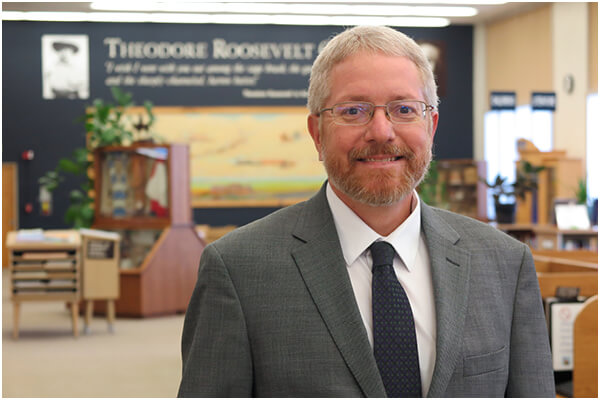
In June 1918, more than 100 students arrived in Dickinson and enrolled at the newly established normal school, an institution designed to train teachers on the norms of pedagogy and curriculum. This summer, the university celebrated its centennial year and alumni from around seven decades gathered for an all-class reunion. As we reminisced together about years gone by, a theme emerged, one that spans each of the 10 decades of DSU’s existence. Dickinson State is a community of people who are committed to serving their community and doing so with excellence.
Dickinson State was established to meet the community need for locally trained teachers who would stay and work in rural communities of southwestern North Dakota. Through the ensuing decades, to meet the needs of a growing community, Dickinson State expanded curriculum beyond teaching, to include business, nursing, agriculture, and more.
Geographically isolated but burgeoning economically, Dickinson and its surrounding region are rapidly, and consistently, expanding as a hub of manufacturing and energy production. The economic development and growth in the community has resulted in increased demand for higher education programs in traditional liberal art fields, as well as in areas of graduate education, continuing education, associate degrees and certificate programs.
Dickinson State University (DSU) must have all new programs be approved by the North Dakota State Board of Higher Education (SBHE) and the North Dakota University System (NDUS). The current interpretation of DSU’s mission has limited the University’s ability to offer programs in technical education and graduate education. Business leaders in the region have expressed their frustration with these limitations, most recently during listening sessions held in spring 2018 with Chancellor Hagerott and with Governor Burgum. Community leaders expressed a desire to see Dickinson State become a destination campus within the University System that offers a blend of liberal arts, continuing education, and technical education that will meet industry needs and attract people to live and work and continually grow along with the area. Aligning the University offerings with business cluster needs helps improve regional and state economies by providing opportunities for “applied learning, research and technology (that) would prepare students to be innovators and entrepreneurs who would lead change locally and globally.”1
Since the listening tours, conversations have continued and one idea that has arisen is to see DSU established as North Dakota’s Polytechnic University. This leads to the question, “what is a Polytechnic University?”
Polytechnic institutions differ from technical colleges (technical institutes), which generally provide post-secondary education and training focusing on vocational skills at the community college level. Polytechnics are comprehensive universities that offer educational opportunities with an emphasis on how knowledge can be used and applied. These opportunities include a curricular blend of programs ranging from certificates, two-year, four-year, graduate and continuing education programs. In all programs of study, students engage in active learning, blending theory and practice together. The “pedagogical approaches in polytechnics embrace student-centered, experiential learning, favored by John Dewey and grounded in the making of meaning from direct experience.”1
According to a report released by the U.S. Department of Education, “education is linked to preparation for employment in specific occupations or careers. Postsecondary credentials in career fields may also lead to further education. In turn, adults participate in formal education and training to acquire, maintain, and upgrade their workforce skills.”2
Dickinson State already offers “polytechnic-like” programming and experience, but needs to be able to embrace the concept officially, and with the backing of the State Board of Higher Education. The University, through strategic partnerships with other NDUS institutions, especially and strongly with Bismarck State College, could begin to offer more technical, skills based programs in Dickinson. An evaluation of industry needs and DSU curriculum will help guide areas of expansion in course offerings.
Dickinson State University is located in the epicenter of regional growth and expansion. With limited access to higher education opportunities, the community looks to Dickinson State University to expand its curricular offerings to encompass not only four-year degrees, but also relevant technical, certificate, associate, continuing education and graduate programs. We look forward to continued conversations among faculty, staff, community and educational leaders. Together we will explore how DSU can develop its offerings to meet the educational needs of the region.
As we celebrate the milestone anniversary of the “College on the Hill,” we look back at the legacy and charge, given to us by those who laid a foundation for the first one hundred years. We also look forward to the future and the opportunities awaiting in our future, paths for us to forge. As we engage in discussions about the future of Dickinson’s University, I invite you to share your thoughts and ideas with me.
Sincerely,
Tom Mitzel, President
Email: Thomas.mitzel@dickinsonstate.edu
Twitter: @mitzel_pres
- Mercer, L. &. (2012). Polytechnic Education-A Proposed Key to Regional Economic Development. Synesis: A Journal of Science, Technology, Ethics & Policy, 45-51. Retrieved from http://www.synesisjournal.com/vol3_t/Mercer_2012_T45-51.pdf
- Levesque, K. L. (2008). Levesque, K., Laird, J., Hensley, E., Choy, S. P., Cataldi, E. F., & Hudson, L. (2008). Career and Technical Education in the United States: 1990 to 2005: Statistical Analysis Report. National Centre for Education Statistics Institute of Education Sciences US Department of Education. Retrieved 5 10, 2018, from https://nces.ed.gov/pubs2008/2008035.pdf

